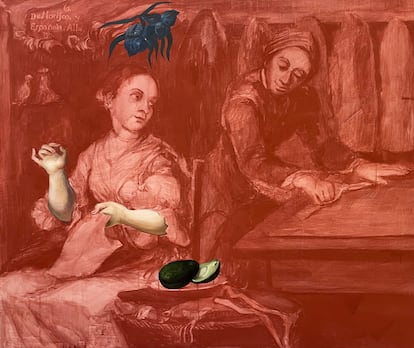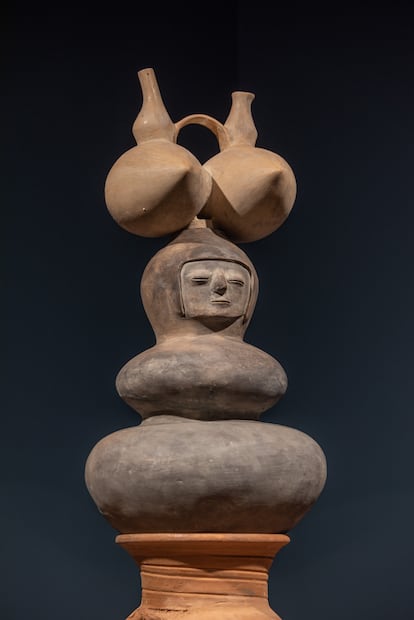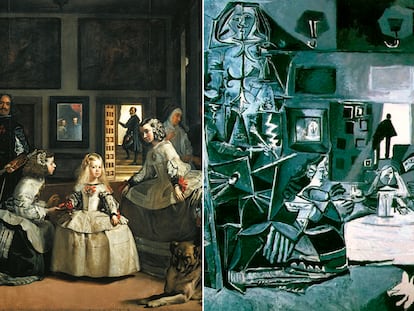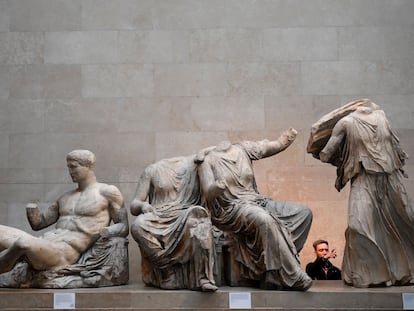Primarily white, male and heterosexual: Spanish art examines its unresolved issues
Creative pursuits in Spain face the challenge of purging the country’s colonial vision, critically reviewing its relationship with the Americas and overcoming a gender bias. Is there a solution? Is it as bad as we think?

The image that opens this article is a work by Sandra Gamarra, 41, a Peruvian artist who has lived in Madrid since 2002 and will be featured in the Spanish pavilion at the Venice Art Biennale in 2024. It will be the first time this commission goes to a person who was not born in Spain. This piece is part of the series Querían brazos y llegamos personas [They wanted arms and we came as people] (2020), which using the caste painting — a genre typical of colonial art in Latin America, which sought to illustrate miscegenation among Spaniards, Indigenous peoples and Africans — as a starting point. The Lima-born Gamarra has a solid international trajectory. She highlights the characters’ arms and fruit species, in an allusion to the material objectives of colonial domination. The artist confesses to being surprised that these themes continue to create a stir. “We are all immersed in this coloniality, our way of life depends on the production of raw materials and labor force from other countries, which we pay for with progress, the same [thing] that has brought us to the current climate crisis, for example. It causes discomfort, of course, because we thought we were doing well,” Gamarra says in an e-mail.
The works that Gamarra’s art recreates belong to a set held by Spain’s National Museum of Anthropology, which is engaged in some soul-searching after announcing the removal of human remains from a public exhibition. Last May, there was also a change in leadership at the Museum of America, founded during dictator Francisco Franco’s regime to extol the concept of Hispanic culture. The new director, Andrés Gutiérrez, has announced his intention to reformulate the collections in order to offer a broader and more critical view of Spain’s relationship with Latin America. In 2022, when Minister of Culture Miquel Iceta wondered how to decolonize a museum, he may not have suspected that the answers would begin to follow. “It is incredible, for example, that an exhibition of the Baroque painter Juan de Pareja has not yet been held here and the Metropolitan Museum of New York has had to do it, in what will surely turn out to be one more neocolonial operation,” explains Sergio Rubira, a professor of Art History at the Universidad Complutense de Madrid. “It is evident that here it is uncomfortable to point out that there were enslaved people during the Golden Age, which has been constructed as a myth.”

The exhibition of Pareja, a Moorish artist who was a contemporary of Velázquez, is an example of the constant re-reading process, which involves thinking about art history today. It seems clear that, in Spain’s case, settling accounts with the colonial past is an unresolved issue. But it isn’t the only one. In 2023 it is impossible to think of museums ordered and closed in aeternum, as Manuel Borja-Villel knew well. During his time at the helm of the Reina Sofia Museum, Borja-Villel drastically rearranged the collection to give greater visibility to gender and different political discourses. “There are many unresolved issues, and some that are considered to be resolved are not,” Rubira adds. “That’s obvious in the case of female artists. There are still group exhibitions in which they are either not included or are a minority, and there are museums where individual exhibitions of women artists are not planned and women curators are not called in.”
In the latest edition of ARCOmadrid, over half of the works that the Ministry of Culture acquired for the Reina Sofia were done by female artists. Among them was a piece from the series Cuánto río allá arriba [So much river upstream] (2020), by Asunción Molinos Gordo, one of the young creators who best articulates the ethical crossroads at which contemporary art finds itself. Indeed, that piece is a nod to the water issue in rural communities in both Spain and Latin America; as such, it was part of Abundant Futures, the exhibition that TBA21, Francesca Thyssen-Bornemisza’s foundation, showed at the C3A in Cordoba last year.

In any case, these are not recent problems; they are part of the very genesis of contemporary art, the origin of which is usually dated back to the 1960s, as Tania Pardo, advisor to Plastic Arts of the Community of Madrid and deputy director of CA2M Centro de Arte 2 de Mayo in Mostoles, Spain, explains. “That art was already a response and a convulsion that catered to minority movements, the second wave of feminism, gender issues, racial movements, LGTBI and social progress,” notes the curator. She highlights the role of creators when it comes to questioning dominant narratives. “Art must generate more plural and egalitarian discourses and pay attention to and restore everything that has been left out of the hegemonic discourse,” she adds. “Hence, the effort and interest in paying attention to movements rooted in popular culture, in issues related to racial, decolonial and gender [themes] [and] discourses centered on class consciousness, functional diversity, ecofeminism and education. There is not one scene; there are several.”
If we had asked art aficionados about the most representative works of Spanish art from the 1990s, they probably would have mentioned Miquel Barceló's cyclopean paintings. Today, however, few doubt that the work of Pepe Espaliú, a gay artist who narrated his experience of HIV through performances, sculptures and works using different techniques, is as relevant in Spain as that of Félix González Torres internationally. Curator and former gallery owner Joaquin Garcia Martin — whose own gallery recovered Espaliú's forgotten works and who exhibited Cuestión de ambiente [A Question of Environment], a show dedicated to Madrid’s sexual diversity in the 1920s at CentroCentro (Madrid, Spain) — knows this issue well. “In the case of sexual dissidents and women artists, their current presence is the result of a lot of work, as well as the enormous quality of their work, which has managed to break down that barrier,” he points out.
In other countries, this reclamation work has taken the form of initiatives like New York’s Museo del Barrio, which includes the Latino and non-white presence in U.S. art. Would something similar be possible in Spain? Are there large groups that are systematically forgotten? “These international institutions respond to places with a strong migrant presence, which is a relatively recent phenomenon in Spain. But that doesn’t mean they didn’t exist [here], and we have to recognize what there was and see what we can do with it,” explains Garcia Martin. But, he says, before discussing their place in museums, detecting them must be the priority. “We don’t know what all those gender-dissident, women and migrant artists were doing. It’s like a DNA chain with missing pieces because they have been hidden from us. First we have to investigate who these people were [and] what became of them and their work. But before that we have to find them, because their existence has been denied to us.”

Curator Chus Martinez — whose impressive career includes work at renowned contemporary art museums like Frankfurter’s Kunstverein, the Museo del Barrio, Kasel’s Documenta and, for years now, Basel’s Institute Art Gender Nature (FHNW) — addresses those gaps. “As to the question of whether we are leaving communities out, the answer is always yes,” she replies. “For example, the Roma community’s cultural production is very understudied, maybe not in music or film, but in the visual arts,” she adds. “That said, I think that in Spain we have generally done our homework well. There is a lot of awareness of the need to recover, pay attention and achieve coherence that may even be greater than in other countries. It is a path on which we must always continue”.
The rewriting continues: as the voices of the first generations of people of Asian-, African-, Arab- or Latin American-descent raised in Spain have been heard in recent years, historians are trying to recompose the puzzle of Spanish society with the missing pieces. The CA2M in Mostoles has dedicated exhibitions to textile art, feminism, migration-related themes and the roots of inequality. Manuel Segade, the director until June 2023, when he begins his appointment as director of the Reina Sofia Museum, is used to dealing with complexity. “The challenge of contemporary art museums is the same one we have in society: not so much inclusion but rather achieving the co-participation of those who seem marginalized. Representation falls short; we must do work to allow each community to access the cultural production of its own story, without forcing [the action, like]a ventriloquist for the other,” he wrote a few weeks before the start of his new appointment.
Chus Martínez agrees with this idea. “We have artists from several generations around us, and we must understand what they’re doing, how they’re doing it and the contexts in which they’re doing it. And [we have] to weave other types of narratives that are not reduced to exhibiting them because they have not been exhibited, or doing a book because they didn’t have one. We need a more complete explanation of what it means to tell our stories.” Sandra Gamarra concurs; sometimes an exhibition is not enough. “I think different communities are increasingly visible, but perhaps what is still needed are spaces that can be created, organized, directed by those communities, not to become totally absorbed and create ghettos, but because I think there are different ways to organize that are equally important for action beyond exhibiting their work,” the artist explains. In this context, it seems logical to think that the unfinished business of art is also the unfinished business of society itself. “Beyond the works exhibited, we have to think about the people who work in museums and the positions they hold,” Segade says. “We can find migrants or racialized people working in the halls, but it is still rare to see them working in the exhibition or collection departments.”
Sign up for our weekly newsletter to get more English-language news coverage from EL PAÍS USA Edition
Tu suscripción se está usando en otro dispositivo
¿Quieres añadir otro usuario a tu suscripción?
Si continúas leyendo en este dispositivo, no se podrá leer en el otro.
FlechaTu suscripción se está usando en otro dispositivo y solo puedes acceder a EL PAÍS desde un dispositivo a la vez.
Si quieres compartir tu cuenta, cambia tu suscripción a la modalidad Premium, así podrás añadir otro usuario. Cada uno accederá con su propia cuenta de email, lo que os permitirá personalizar vuestra experiencia en EL PAÍS.
¿Tienes una suscripción de empresa? Accede aquí para contratar más cuentas.
En el caso de no saber quién está usando tu cuenta, te recomendamos cambiar tu contraseña aquí.
Si decides continuar compartiendo tu cuenta, este mensaje se mostrará en tu dispositivo y en el de la otra persona que está usando tu cuenta de forma indefinida, afectando a tu experiencia de lectura. Puedes consultar aquí los términos y condiciones de la suscripción digital.
More information
Archived In
Últimas noticias
Pinochet’s victims grapple with José Antonio Kast’s rise in Chile
Reinhard Genzel, Nobel laureate in physics: ‘One-minute videos will never give you the truth’
Half of Scotland is in the hands of 420 property owners
From digital curfews to blocking apps: How technology experts protect their children online
Most viewed
- Pablo Escobar’s hippos: A serious environmental problem, 40 years on
- Reinhard Genzel, Nobel laureate in physics: ‘One-minute videos will never give you the truth’
- Why we lost the habit of sleeping in two segments and how that changed our sense of time
- Charles Dubouloz, mountaineering star, retires at 36 with a farewell tour inspired by Walter Bonatti
- The Florida Keys tourist paradise is besieged by immigration agents: ‘We’ve never seen anything like this’











































